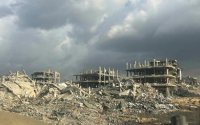20 February 2006Manila Standard Today
Green groups have accused the government of ignoring the threat of natural disasters after a massive landslide wiped Guinsaugon in Leyte, leaving some 1,400 people missing.
"The combined threats of destructive logging and climate change should be taken seriously by the Philippine government," Von Hernandez, campaigns director of Greenpeace Southeast Asia, said in a statement.
"The scale and frequency of similar tragedies in the past should have, long before, already provoked the government into action to address the seemingly perennial problems of floods and landslides at the source."
Hernandez made his statement even as Malacañang said that two years ago, the Department of Environment and Natural Resources warned government officials on Southern Leyte that a wide lowland area in the province, including St. Bernard town, was prone to landslides.
Executive Secretary Eduardo Ermita said the department had urged local residents to take extra precautions following the series of landslides in the province in December 2003.
"The local executives were told to caution residents that a similar disaster could happen again, and it did," Ermita said by phone.
President Gloria Macapagal Arroyo has tasked Ermita to head an interagency task force that would look into the cause of last week's landslides.
Experts say the latest landslide on Leyte—which sits on a major geological fault and is in the path of most major typhoons—was a geographical accident waiting to happen.
Since 1991 four deadly landslides or floods have struck the region. In November that year, flash floods and landslides killed about 5,000 people in Ormoc City.
The latest landslide on Southern Leyte has prompted a top researcher to warn that Asian nations must improve warning systems and disaster management to confront an increasing number of tragedies linked to heavy rains.
"In general, we are observing more and more heavy-rain associated disasters in the region," said Srikantha Herath, of the environment and sustainable development program at the United Nations University in Tokyo.
"So it is necessary to look for measures to anticipate and warn in advance," Herath told Agence France-Presse in a telephone interview.
Defense Secretary Avelino Cruz said 500 mm of rain had fallen on Leyte since Feb. 1, nearly five times the average for the month.
"Leyte island is prone to extreme rainfall," said Herath, noting that in this case, even a mild earthquake like the 2.6-magnitude tremor that hit before the tragedy could have been enough to shake loose the rain-soaked earth.
Southeast Asia has seen an increased intensity of rainfall and, in some cases, the rains are coming later, Herath said. But the region lacks data on these tropical downpours, which could help prevent future tragedies.
"It's a combination of tiny things that create natural disasters," said Herath, a civil engineer. "In order to prevent them, we really have to improve our monitoring ability tremendously." AFP and Fel V. Maragay






